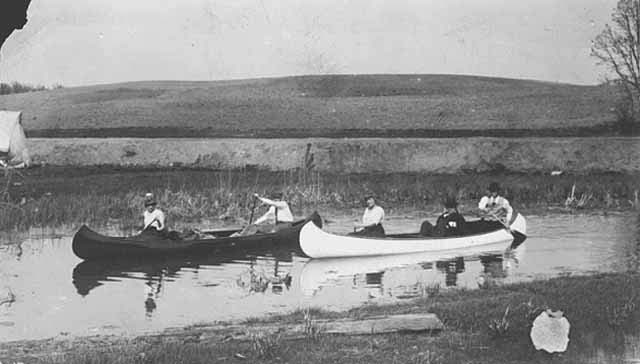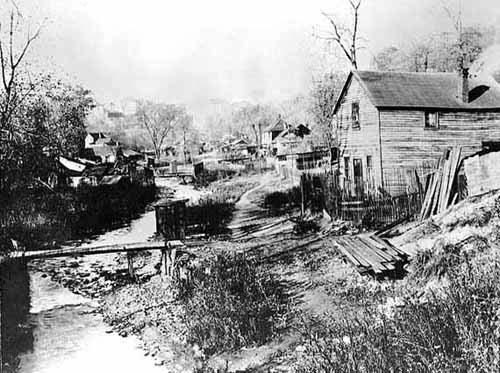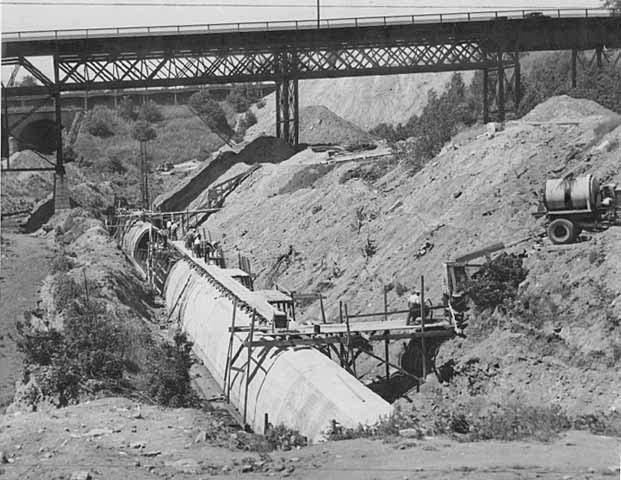 |
|
|
|
Phalen Creek Tunnel Half-Assed History Lesson Part |
 Some dudes canoeing on Phalen Creek in 1910, before this section was entombed. |
| Lower
Phalen Creek was once a spring fed-stream flowing from Lake Phalen through
a deep ravine it had gouged from the land, and into a low delta on the
Mississippi River floodplain. Surrounded by forests and wetlands, the
creek formed a natural corridor for migrating songbirds and other wildlife
traveling between the Mississippi and Phalen Chain of Lakes. Native
American tribes offered prayers and held councils in the nearby caves.
The outlet and small delta at its mouth is thought to be the place at
which Fr. Louis Hennepin landed on his journey to discover the falls
of St. Anthony in 1680.
In 1838, Edward "Big Ed" Phelan was discharged from Fort Snelling. He moved into a ramshackle house he had built with another discharged soldier named John Hays. The two didn't get along for shit, however, and when Hays went missing and was eventually found dead, floating in the Mississippi River near Carver's Cave, the authorities at Fort Snelling arrested Phelan for murder. (Hays's murder was the first homicide ever committed in Saint Paul, FYI.) He spent six months in the territorial prison at Prairie du Chien, but then a dying Indian confessed to the crime on his deathbed and Phelan was freed. Sounds pretty fishy to me, but I wasn't there. Anyway, getting back to the creek; by the time he'd gotten out of prison, Phelan had lost his rights to his old land claim, so he took up a new one at the falls of Phelan's Creek. He sold this in 1844 and went on to claim several other plots of land along the creek that was later to be named after him. (In 1850, Phelan fled the state for California, to flee from the Ramsey County sheriff on new criminal charges. He behaved so violently toward his traveling companions that they were forced to kill him in self-defense.) |
 1912: Looking north into Swede Hollow from East 7th St before the creek was enclosed. |
|
Anyway, as more and more European immigrants settled in the area, much of the natural landscape disappeared. Baptist Hill, where pioneers had watched for arriving steamboats and fired cannons to celebrate Union victories in the Civil war, was completely sliced away in the 1870's, and the rubble used by the railroad companies to fill in the Trout Brook and Phalen Creek river valley. Between the 1890s and the 1930s, the railroad companies totally entombed Lower Phalen Creek within underground tunnels, and the creek's delta was filled and used as a railyard. |
 Section of Phalen Creek between Third Street and East Sixth Street being enclosed: July of 1936. The mouth of an even larger older section is visible at back left. |
|
The bluff-tops became the Railroad Island and Dayton's Bluff neighborhoods of St. Paul's East Side. The ravine became known as Swede Hollow, and waves of new immigrants lived in a shantytown there until the 1950s. By the 1970s railroad use declined, and the abused floodplain was abandoned. Today, Lower Phalen Creek is primarily a storm sewer, its water largely comprised of rain and snowmelt. Swede Hollow has been made into a park, and neighborhood activists are working to improve its ecological quality. Even the most daring of these plans do not call for unburying Phalen Creek from its tunnel tomb, thank goodness. I love nature and all ... but I love giant old tunnels even more. |
|
